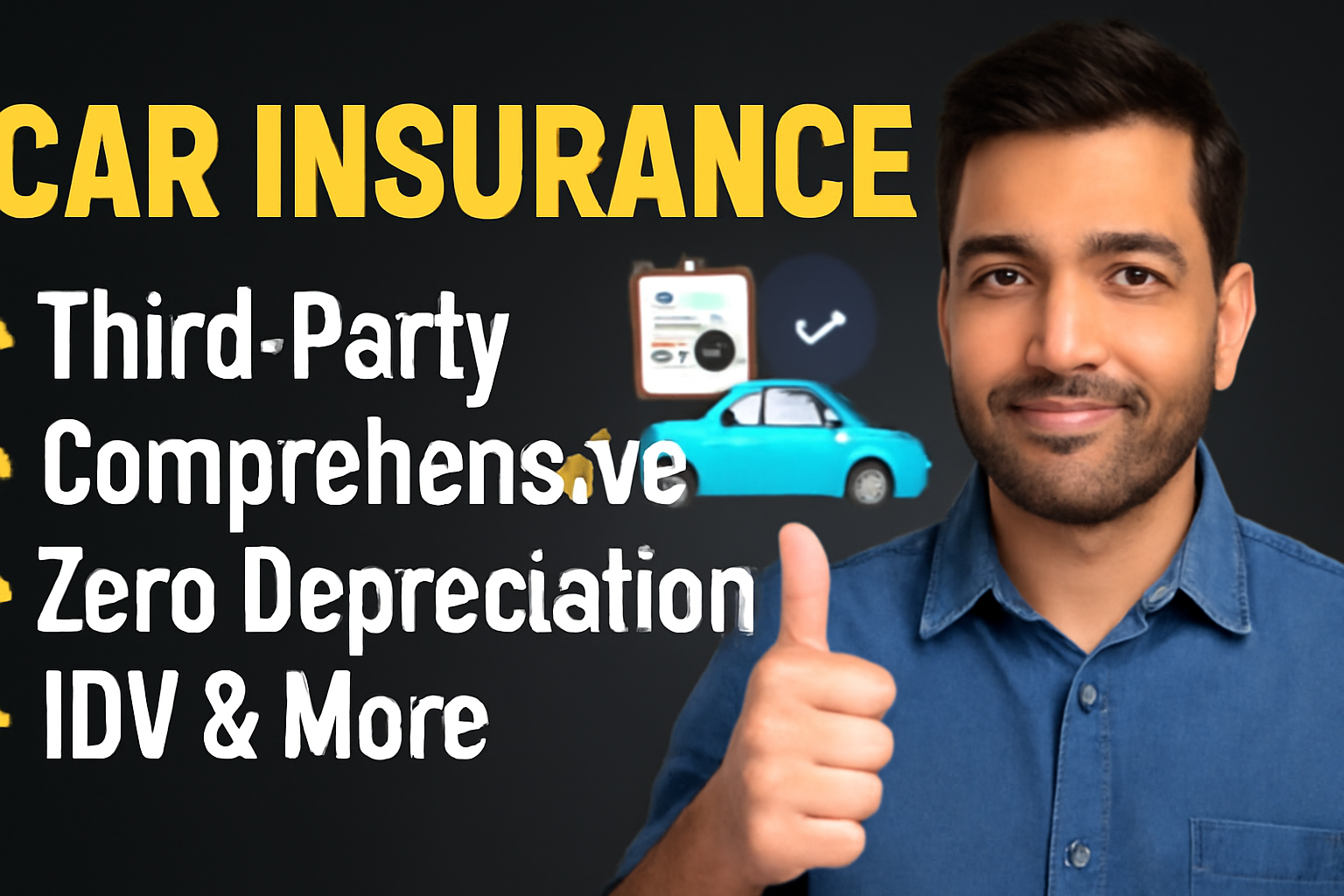Introduction to Car Insurance
Friends, in this video, we’ll discuss car insurance. Let me first give you a quick overview of what we’ll cover, so you know exactly what to expect. At the outset, I’ll explain some common terms related to car insurance. We’ll start with third-party car insurance—what it means and what it covers. Then we’ll look at first-party insurance, which is also known as comprehensive insurance. You might have also heard of zero-depreciation insurance, sometimes called ‘zero-dep’ or ‘bumper-to-bumper’ insurance— we’ll understand that as well.
Insured Declared Value (IDV)
You might have heard of IDV, or insured declared value. For example, you have a car which is now 4 years old, but when you bought it, it was worth ₹10 lakhs. Now it’s 4 years old and you have to renew its insurance. Now, how will you determine the value of this car? Will it be ₹8 lakhs, ₹6 lakhs, ₹4 lakhs, or ₹5 lakhs? What will you deem to be the value of the car when you go for a new insurance? This is the IDV or insured declared value. So, we shall see a little about this as well.
Return to Invoice (RTI)
There are a few other points as well – excuse me – we shall see the zero-depreciation insurance; there is another thing called RTI, or return to invoice. E.g., you had bought a car for ₹10 lakhs 4 years ago and now its IDV is ₹5 lakhs. Now, if the car gets stolen tomorrow, then the RTI will play a role in determining whether you will get ₹5 lakhs or ₹10 lakhs in the insurance claim. So, we’ll look into that too.
The Process of Insurance Quotation
Let’s start the video from here with the basic things. I had to tell you another thing, let me first tell you, then we shall start the video. This is a quotation; someone known to me wanted to buy a car recently. The car was an XUV – under this, there are a few models – this model was XUV AX7. This was automatic. The quotation for this is the sheet of paper you see in front of you. Here is the name of the agency, which I have blurred as it is not allowed on YouTube, to show personal information. The value of the car in the quotation ₹20.99 lakhs, which is virtually ₹21 lakhs.
Ex-Showroom Price and Insurance Costs
Apart from this, there would be insurance as well, then there’re RTO charges as well. Altogether, the on-road price would be ₹23.30 lakhs. What I want to say is that when we went to get this quotation from the agency with someone I knew who wanted to buy the car, the agency said the ex-showroom price is ₹20.99 lakhs; and this can be negotiated when you sit at the table.
Understanding First-Party and Third-Party Insurance
We shall understand all the points one by one. When we insure a brand-new car, which is still in the showroom, for the first time, then whatever the ex-showroom price of the car is – ₹20.99 lakhs in this case – deduct 5% from that. Whenever you get insurance on a car that’s left the showroom, its value comes down by 5%. So, our ex-showroom price will decrease by 5%. So, 95% of ₹20.99 lakhs will be ₹1994050. This ₹1994050 will be considered as the IDV or insured declared value.
Insurance from ICICI Lombard
Then we came back home and went to the ICICI Lombard page and applied on our own – we have put ₹1994050 as 95% of the car’s value, which was ₹20.99 lakhs. So, the IDV is ₹1994050. And it’s written here 1 year + 3 year third party, which means comprehensive or first-party insurance for 1 year, plus third-party insurance for 3 years, same as before. How much are they charging?
Comparison of Insurance Prices
I have added everything here – zero-depreciation – I will explain all of this, but first, let’s compare. I have added everything like zero depreciation, 24×7 roadside assistance, engine protection covers, consumables, key and lock replacement, RTI, i.e., return to invoice – there is nothing that I’ve missed. I am getting this insurance from home for ₹61503 and I was getting the same for ₹1.05 lakhs from the agency. We could negotiate, and they’d give a discount of ₹10k maximum.
Common Mistakes in Insurance Purchases
We often go to the dealer, a nearby shop, or an agency to buy or renew their insurance. This is often because they feel they don’t have enough knowledge and worry that if they miss something important, they might face problems getting a claim in case of an accident. Firstly, people are afraid to do it, and secondly, they lack knowledge. Car insurance and two-wheeler insurance are actually so simple that even a 5th-grade student can understand them.
Mandatory Features in Car Insurance
Now, you can clearly understand the difference. I’ll explain all the things and give another example as well. This is for new car insurance for someone; but I use a Venue of Hyundai and recently I renewed the insurance, and as it’s 4 years old, I put the IDV at ₹5 lakhs. I asked for a quotation, and the store owner gave me a quotation of ₹18k. But when I did it on my own, adding all the same things, I got that at ₹11k. I would’ve paid ₹7k extra for the thing that I can do on my own from home.
Third-Party Insurance Explained
So, first, what is third-party insurance? Suppose this is my car driving on the road, and another car comes from the opposite direction. An accident happens—and it was my fault. Both cars get damaged. But I only have third-party insurance. Now the question is: who is the third party? All the other cars on the road are third-party. As I had only third-party insurance and the fault was also mine, my insurance company will compensate for all the damage that the other car and the owner had.
Comprehensive Insurance Explained
Secondly, suppose, I’ve first-party insurance, and this time too it was my fault and both the cars got damaged in the accident. In this case, as I have first-party insurance, my insurance company will pay for the damage of both my car and the other car.
Depreciation and Insurance Coverage
The first-party insurance, what we also call comprehensive insurance, has a drawback. Suppose, both the cars got damaged, and the damage for both cars is worth total ₹50k – ₹25k each. Then, will the entire ₹50k be paid by our insurance company? The answer is ‘no’. When we only take the first-party insurance then the third party will obviously be there – this is what we refer to as Comprehensive.
Zero-Depreciation Insurance
When we have zero-depreciation insurance, under which, whatever expenses there are, the agency will deal with it, in the sense, my car insurance company will reimburse me. Some people would then say that they can take a third-party insurance, which is cheaper, and take a zero-depreciation with it, so a first-party insurance won’t be necessary. That way, zero-dep will cover everything, body to body.
Conclusion and Final Tips
So, don’t be confused. Let’s just recap; third-party is for the other person, that is not our headache. If I’m taking first-party just for myself, which is the Comprehensive, then whatever my claim is, I’ll get 50% of that and I’ll have to pay the rest from my pocket. But if I am taking first-party, and zero-depreciation as add-on, along with it, then the exterior body to body, whatever be the damage – glass, plastic, tyres, etc. – I will get 100% reimbursement.


